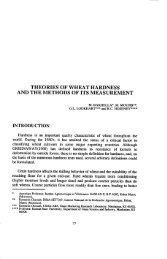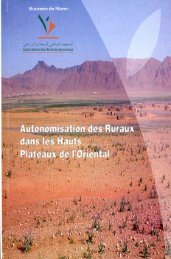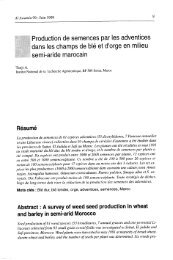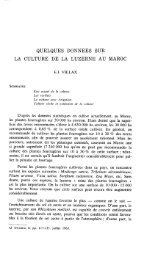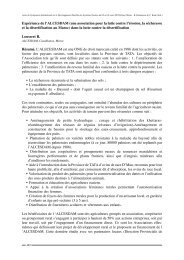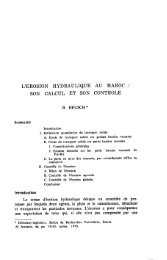Jamaly et al. 1773assayed before using LAB strains in dairy manufacturing.The haemolytic activity constitutes a potential pathogenictrait that can be displayed by <strong>Enterococci</strong>. However, none<strong>of</strong> the E. durans tested produced haemolysin when testedon sheep blood. The absence <strong>of</strong> such activity should be acriterion for selecting strains to be used as starter oradjunct cultures in dairy products (Giraffa, 1995).It is known that nisin is the most extensively studiedbacteriocin and has been approved for use as a foodpreservative (Jung et al., 1992; Davies et al., 1999; Choiand Park, 2000; Chen and Hoover, 2003). All isolates <strong>of</strong>E. durans were able to grow in the presence <strong>of</strong> highconcentration <strong>of</strong> nisin ( 0.8 mg m1 -1 ) (Table 3). Theseresults show that the isolates <strong>of</strong> this study can be used indairy products in the presence <strong>of</strong> nisin or nisin-producingLAB strains. Another important safety criterion to beconsidered when selecting strains as starter or adjunctcultures is their ability to withstand antibiotic. Anincreasing number <strong>of</strong> <strong>Enterococci</strong> resistant to differentclasses <strong>of</strong> antibiotic is being reported in the last years(Bertrand et al., 2000; Facklam et al., 2002; Leclercq,2009). A major concern is the emergence <strong>of</strong> vancomycinrestistant <strong>Enterococci</strong> (VRE). Vancomycin is consideredas the last resort antibiotic to treat serious infections dueto resistant Gram-positive bacteria, and given exclusivelyin a clinical environment, when all others fail. All the E.durans isolates studied had vancomycin MICs < 2 µg ml -1(Table 3). According to CLSI (2006) and European FoodSafety Authority (EFSA) (2008) Enterococcus antibioticresistance interpretive criteria, these E. durans isolatehad vancomycin MICs in the susceptible range (susceptible,4 g m1 -1 ; intermediate, 8 - 16 g m1 -1 ; resistant,32 g m1 -1 ). The absence <strong>of</strong> vancomycin resistance canbe considered a positive trait for these bacteria isolatesfor their use in food manufacture.ConclusionsAmong the 23 E. durans <strong>isolated</strong> <strong>from</strong> Moroccan dairyproducts studied a wide technological potential differencebetween isolates <strong>from</strong> the same or different sources wasobserved. A rapid decrease in pH during the initial steps<strong>of</strong> cheese preparation is <strong>of</strong> crucial importance in cheesemanufacture, while the ability <strong>of</strong> strains to lyse andsubsequently release their intracellular enzymes is adesirable trait during the ripening <strong>of</strong> cheese. In general,enterococci are not suitable as starter cultures because<strong>of</strong> their scarce acidifying ability, but they may be useful asgood adjunct cultures. All E. durans characterized in thisstudy were able to produce exo-polysaccharides (EPS),and had potential metabolic traits involved in cheeseripening and in aroma and flavour development in variousfermented food. Moreover, most <strong>of</strong> the isolates were ableto tolerate a high concentration <strong>of</strong> nisin, allowing their usein the presence <strong>of</strong> this food biopreservative.As none <strong>of</strong> the E. durans <strong>isolated</strong> was haemolitic orshowed vancomycin resistance, the possibility to safelyuse them in health added value dairy products could betaken into account. Further studies should be carried outon potential probiotic traits and other safety issues, as thepresence <strong>of</strong> genes coding for virulence factors andantibiotic resistance, before using these isolates thatcolonize typical Moroccan dairy products as adjunctcultures.For the first time in Morocco, E. durans <strong>isolated</strong> <strong>from</strong>different dairy products were characterized for theirtechnological potential. The interesting technologicaltraits showed by the isolates are important findings forthe constitution <strong>of</strong> the National Center <strong>of</strong> LAB (starter,adjunct cultures and probiotics) in Morocco.ACKNOWLEDGEMENTSWe thank the technician Mrs Maria Carmen Fozzi <strong>of</strong> theDipartimento per la Ricerca nelle Produzioni Animali(AGRIS Sardegna, Italy) for helping with species-specificPCR. This work was supported by INRA and University <strong>of</strong>Mohammed V, Morocco.REFERENCESAimutis WR (2004). Bioactive Properties <strong>of</strong> Milk Proteins with ParticularFocus on Anticariogenesis. J. Nutr., 134: 989S-95S.Andrighetto C, Knijff E, Lombardi A, Torriani S, Vancanneyt M, KerstersK, Swings J, Dellaglio F (2001). Phenotypic and genetic diversity <strong>of</strong>enterococci <strong>isolated</strong> <strong>from</strong> Italian cheeses. J. dairy. Res., 68: 303-316.Beresford TP, Fitzsimons NA, Brennan NL, Cogan TM (2001). Recentadvances in cheese microbiology. Int. dairy, J., 11: 259-274.Bertrand X, Mulin B, Viel JF, Thouverez M, Talon D (2000). CommonPFGE patterns in antibiotic-resistant Enterococcus faecalis <strong>from</strong>humans and cheeses. Food. Microbiol., 17: 543-551.Bouksaim M, Fliss I, Merhrous J, Simard RE, Lacroix C (1998).Immunodot detection <strong>of</strong> nisin Z in milk and whey using enhancedchemiluminescence. J. Appl. Microbiol., 84: 176-184.Boutrou R, Sepulchre A, Pitel G, Durier C, Vassal L, Gripon JC, MonnetV (1998). Lactococcal lysis and curd proteolysis: Two predictableevents important for the development <strong>of</strong> cheese flavour. Int. dairy. J.,8: 609-616.Casalta E, Zennaro R (1997). Effect <strong>of</strong> specific starters onmicrobiological, biochemical and sensory characteristics <strong>of</strong> Venaco, aCorsican s<strong>of</strong>t cheese. Sci. Alim., 17: 79-94.Centeno JA, Menendez S, Hermida MA, Rodriguez-Otero JL (1999).Effects <strong>of</strong> the addition <strong>of</strong> Enterococcus faecalis in Cebreiro cheesemanufacture. Int. J. Food. Microbiol., 48: 97-111.Centeno JA, Menendez S, Rodriguez-Otero JL (1996). Main microbialflora present as natural starters in Cebreiro raw cow's-milk cheese(northwest Spain). Int. J. Food. Microbiol., 33: 307-313.Chen H, Hoover DG (2003). Bacteriocins and their food application.Comprehensive Rev. Food Sci. Food Safety, 2: 82-100.Choi MH, Park YH (2000). Selective control <strong>of</strong> lactobacilli in Kimichi withnisin. Lett. Appl. Microbiol., 30: 173-177.Christensen JE, Dudley EG, Pederson JA, Steele JL (1999).Peptidases and amino acid catabolism in lactic acid bacteria. AntonieVan Leeuwenhoek, 76: 217-246.Church FC, Swaisgood HE, Porter DH, Catignani GL (1983).Spectrophotometric assay using o-phthaldialdehyde for determination<strong>of</strong> proteolysis in milk and <strong>isolated</strong> milk proteins. J. Dairy. Sci., 66:1219-1227.Clinical and Laboratory Standards Institute (CLSI) (2006). Methods fordilution antimicrobial susceptibility tests for bacteria that growaerobically. Approved standard—seventh edition. CLSI documentM7-A7. Clinical and Laboratory Standards Institute, Wayne, PA.4.Davies EA, Milne CF, Bevis HE, Potter RW, Harris JM, Williams GC,
1774 Afr. J. Microbiol. Res.Thomas LV, Delves-Broughton J (1999). Effective use <strong>of</strong> nisin to controllactic acid bacterial spoilage in vacuum packed bologna-typesausage. J. Food. Protect., 62: 1004-1010.De Kwaadsteniet M, Todorov S, Knoetze H, Dicks L (2005).<strong>Characterization</strong> <strong>of</strong> a 3944 Da bacteriocin, produced by Enterococcusmundtii ST15, with activity against Gram+ and Gram- bacteria. Int. J.Food. Microbiol., 105: 433-444.De Vuyst L, Foulquié Moreno MR, Revets H (2003). Screening forenterocins and detection <strong>of</strong> hemolysin and vancomycin resistance inenterococci <strong>of</strong> different origins. Int. J. Food. Microbiol., 84: 299-318.Durlu-Ozkaya F, Xanthopoulos V, Tunail N, Litopoulou-Tzanetaki E(2001). Technologically important properties <strong>of</strong> lactic acid bacteriaisolates <strong>from</strong> Beyaz cheese made <strong>from</strong> raw ewes' milk. J. Appl.Microbiol., 91: 861-870.Ennahar S, Deschamps N (2000). Anti-Listeria effect <strong>of</strong> enterococin A,produced by cheese-<strong>isolated</strong> Enterococcus faecium EFM01, relativeto other bacteriocins <strong>from</strong> lactic acid bacteria. J. Appl. Microbiol., 88:449-457.European Food Safety Authority (EFSA) (2008). Technical guidance-Update <strong>of</strong> the criteria used in the assessment <strong>of</strong> bacterial resistanceto antibiotics <strong>of</strong> human or veterinary importance. EFSA J., 732: 1-15.Facklam RR, Carvalho MGS, Teixera LM (2002). History, taxonomy,biochemical characteristics, and antibiotic susceptibility testing <strong>of</strong><strong>Enterococci</strong>. In: Gilmore MS (eds) The <strong>Enterococci</strong>: pathogenesis,molecular biology, and antibiotic resistance. American Society forMicrobiology, Washington, DC, Chapter, 1: 1-54.Foulquié Moreno MR, Sarantinopoulos P, Tsakalidou E, De Vuyst L(2006). The role and application <strong>of</strong> <strong>Enterococci</strong> in food and health.Int. J. Food. Microbiol., 106: 1-24.Fox PF, Wallace JM (1997). Formation <strong>of</strong> flavor compounds in cheese.Adv. Appl. Microbiol., 45: 17-85.Franciosi E, Settanni L, Cavazza A, Poznanski E (2009). Biodiversityand technological potential <strong>of</strong> wild lactic acid bacteria <strong>from</strong> raw cows'milk. Int. dairy. J., 19: 3-11.Gardiner GE, Ross RP, Wallace JM, Scanlan FP, Jagers PP,Fitzgerald GF, Collins JK, Stanton C (1999). Influence <strong>of</strong> a probioticadjunct culture <strong>of</strong> Enterococcus faecium on the quality <strong>of</strong> Cheddarcheese. J. Agr. Food. Chem., 47: 4907-4916.Ghrairi T, Frere J, Berjeaud J, Manai M (2008). Purification andcharacterisation <strong>of</strong> bacteriocins produced by Enterococcus faecium<strong>from</strong> Tunisian rigouta cheese. Food. Control, 19: 162-169.Giraffa G (1995). Enterococcal bacteriocins: their potential as anti-Listeria factors in dairy technology. Food. Microbiol., pp 291-299.Giraffa G (2003). Functionality <strong>of</strong> enterococci in dairy products. Int. J.Food. Microbiol., 88: 215-222.Giraffa G, Carminati D, Neviani E (1997). <strong>Enterococci</strong> <strong>isolated</strong> <strong>from</strong>dairy products: a review <strong>of</strong> risks and potential technological use. J.Food. Protect,, 60: 732-738.González L, Sacristán N, Arenas R, Fresno JM, Tornadijo M E (2010).Enzymatic activity <strong>of</strong> lactic acid bacteria (with antimicrobialproperties) <strong>isolated</strong> <strong>from</strong> a traditional Spanish cheese. Food.Microbiol., 27: 592-597.Hugenholtz J (1993). Citrate metabolism in lactic acid bacteria. FEMS.Microbiol. Rev., 12: 165-178Huycke MM, Sahm DF, Gilmore MS (1998). Multiple-drug resistantenterococci: the nature <strong>of</strong> the problem and an agenda for the future.Emerg. Infect. Dis., 4: 239-249.Jackson CR, Fedorka-Cray PJ, Barrett JB (2004). Use <strong>of</strong> a genus -andspecies-specific multiplex PCR for identification <strong>of</strong> enterococci. J.Clin. Microbiol., 42: 3558-3565.Jung DS, Bodyfelt FW, Daeschel MA (1992). Influence <strong>of</strong> fat andemulsifiers on the efficacy <strong>of</strong> nisin in inhibiting Listeriamonocytogenes in fluid milk. J. Dairy. Sci., 75: 387-393.Ke D, Picard FJ, Martineau F, Ménard C, Roy PH, Oullette M, BergeronMG (1999). Development <strong>of</strong> a PCR Assay for Rapid Detection <strong>of</strong><strong>Enterococci</strong>, J. Clin. Microbiol., 37: 3497-3503.Kempler GM, Mc Kay LL (1980). Improved medium for detection <strong>of</strong>citrate-fermenting Streptococcus lactis subsp. diacetylactis. Appl.Env. Microbiol., 39: 926-927.Leclercq R (2009). Epidemiological and resistance issues in multidrugresistant staphylococci and enterococci. Clin. Microbiol. Infect., 15:224-231.Litopoulou-Tzanetaki E, Tzanetakis N, Vafopoulou-Mastrojiannaki A(1993). Effect <strong>of</strong> the type <strong>of</strong> lactic starter on microbiological, chemicaland sensory characteristics <strong>of</strong> Feta cheese. Food. Microbiol., 10: 31-41.Lortal S, Chapot-Chartier MP (2005). Role mechanisms and control <strong>of</strong>lactic acid bacteria lysis in cheese. Int. dairy J., 15: 857-871.Manolopoulou E, Sarantinopoulos P, Zoidou E, Aktypis A,Moschopoulou E, Kandarakis, IG, Anifantakis EM (2003). Evolution <strong>of</strong>microbial populations during traditional Feta cheese manufacture andripening. Int. J. Food. Microbiol., 82: 153-161.Maragkoudakis PA, Konstantinos CM, Psyrras D, Cremonese S,Fischer J, Cantor MD, Tsakalidou E (2009). Functional properties <strong>of</strong>novel protective lactic acid bacteria and application in raw chickenmeat against Listeria monocytogenes and Salmonella enteriditis. Int.J. Food. Microbiol., 130: 219-226.Meisel H, Schlimme E (1996). Bioactive peptides derived <strong>from</strong> milkproteins: Ingredients for functional foods?. Kieler MilchwirtschaftlicheForschungsberichte, 48: 343-357.Mora D, Fortina MG, Parini C, Ricci G, Gatti M, Giraffa G, Manachini PL(2002). Genetic diversity and technological properties <strong>of</strong>Streptococcus thermophilus strains <strong>isolated</strong> <strong>from</strong> dairy products. J.Appl. Microbiol., 93: 278-287.Morandi S, Brasca M, Andrighetto C, Lombardi A, Lodi R (2006).Technological and molecular characterisation <strong>of</strong> enterococci <strong>isolated</strong><strong>from</strong> north-west Italian dairy products. Int. Dairy. J., 16: 867-875.Ogier JC, Serror P (2008). Safety assessment <strong>of</strong> dairy microorganisms:The Enterococcus genus. Int. J. Food. Microbiol., 126: 291-301.Oumer A, Gaya P, Fernández-Garcia E, Mariaca R, Garde S, MedinaM, Nuñez M (2001). Proteolysis and formation <strong>of</strong> volatile compoundsin cheese manufactured with bacteriocin-producing adjunct starter. J.dairy. Res., 68: 117–129.Parente E, Cogan TM (2004). Starter cultures: general aspects. In:Franciosi E, Settanni L, Cavazza A, Poznanski E (2009). Biodiversityand technological potential <strong>of</strong> wild lactic acid bacteria <strong>from</strong> raw cows'milk. Int. dairy J., 19: 3-11.Pelaez C, Requena T (2005). Exploiting the potential <strong>of</strong> bacteria in thecheese ecosystem. Int. dairy J., 15: 831-844.Psoni L, Kotzamanides C, Andrighetto C, Lombardi A, Tzanetakis N,Litopoulou-Tzanetaki E (2006). Genotypic and phenotypicheterogeneity in Enterococcus isolates <strong>from</strong> Batzos, a raw goat milkcheese. Int. J. Food. Microbiol., 109: 109-120.Sarantinopoulos P, Andrighetto C, Georgalaki MD, Rea M.C, LombardiA, Cogan TM, Kalantzopoulos G, Tsakalidou E (2001). Biochemicalproperties <strong>of</strong> enterococci relevant to their technological performance.Int. Dairy J., 11: 621-647.Sarantinopoulos P, Kalantzopoulos G, Tsakalidou E (2002a). Effect <strong>of</strong>Enterococcus faecium on microbiological, physicochemical andsensory characteristics <strong>of</strong> Greek Feta cheese. Int. J. Food Microbiol.,76: 93-105.Sarantinopoulos P, Leroy F, Leontopoulou E, Georgalaki M,Kalantzopoulos G, Tsakalidou E, De Vuyst L (2002b). Bacteriocinproduction by Enterococcus faecium FAIR-E 198 in view <strong>of</strong> itsapplication as adjunct starter in Greek Feta cheese making. Int. J.Food. Microbiol., 72: 125-136.Schellhaas SM (1983). <strong>Characterization</strong> <strong>of</strong> exocellular slime producedby bacterial starter cultures used in the manufacture <strong>of</strong> fermenteddairy products. In: Wouters JTM, Ayad EHE, Hugenholtz J, Smit G(2002). Microbes <strong>from</strong> raw milk for fermented dairy products. Int.dairy J., 12: 91-109.Suzzi G, Caruso M, Gardini F, Lombardi A, Vannini L, Guerzoni ME,Andrighetto C, Lanorte MT (2000). A survey <strong>of</strong> the enterococci<strong>isolated</strong> <strong>from</strong> an artisanal Italian goat's cheese (semicotto caprino). J.Appl. Microbiol., 89: 267-274.Tzanetakis N, Vafopoulou-Mastrojiannaki A, Litopoulou-Tzanetaki E(1995). The quality <strong>of</strong> white-brined cheese <strong>from</strong> goat's milk made withdifferent starters. Food. Microbiol., 12: 55-63.Villani F, Coppola S (1994). Selection <strong>of</strong> enterococcal strains for waterbuffaloMozzarella cheese manufacture. Ann. Microbiol. Enzim., 44:97-105.Wessels D, Jooste PJ, Mostert JF (1990). Technologically importantcharacteristics <strong>of</strong> Enterococcus isolates <strong>from</strong> milk and dairy products.Int. J. Food Microbiol., 10: 349-352.




